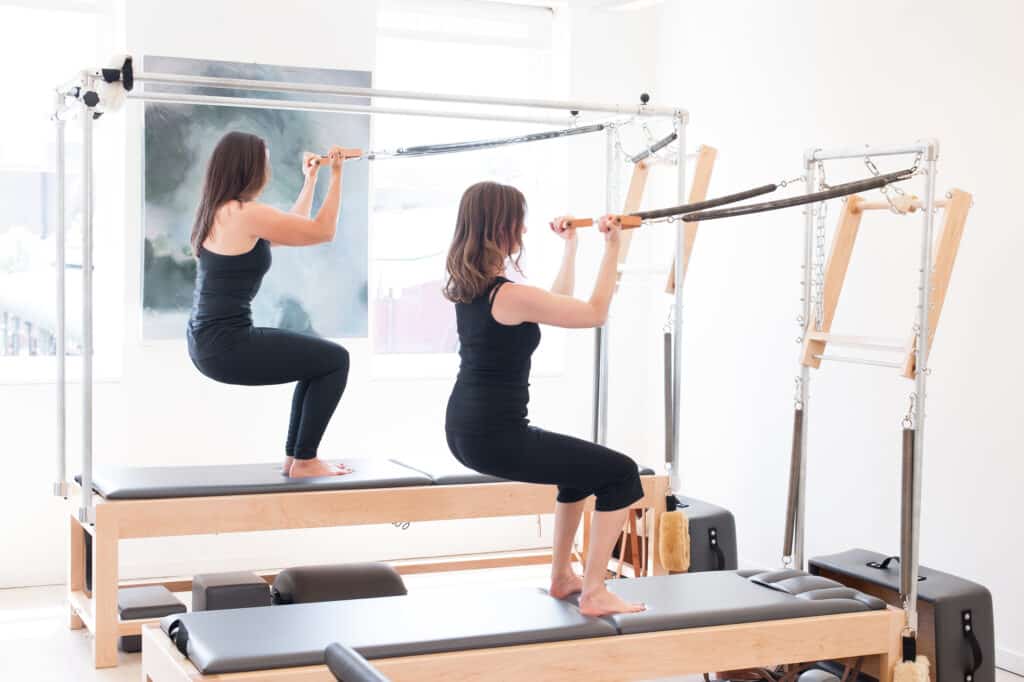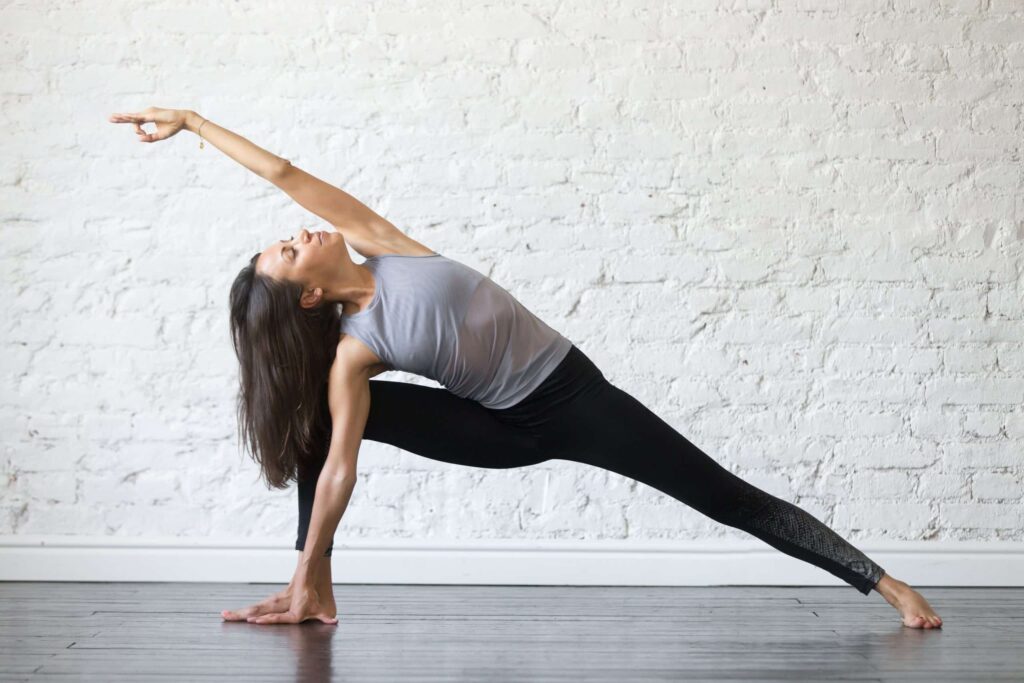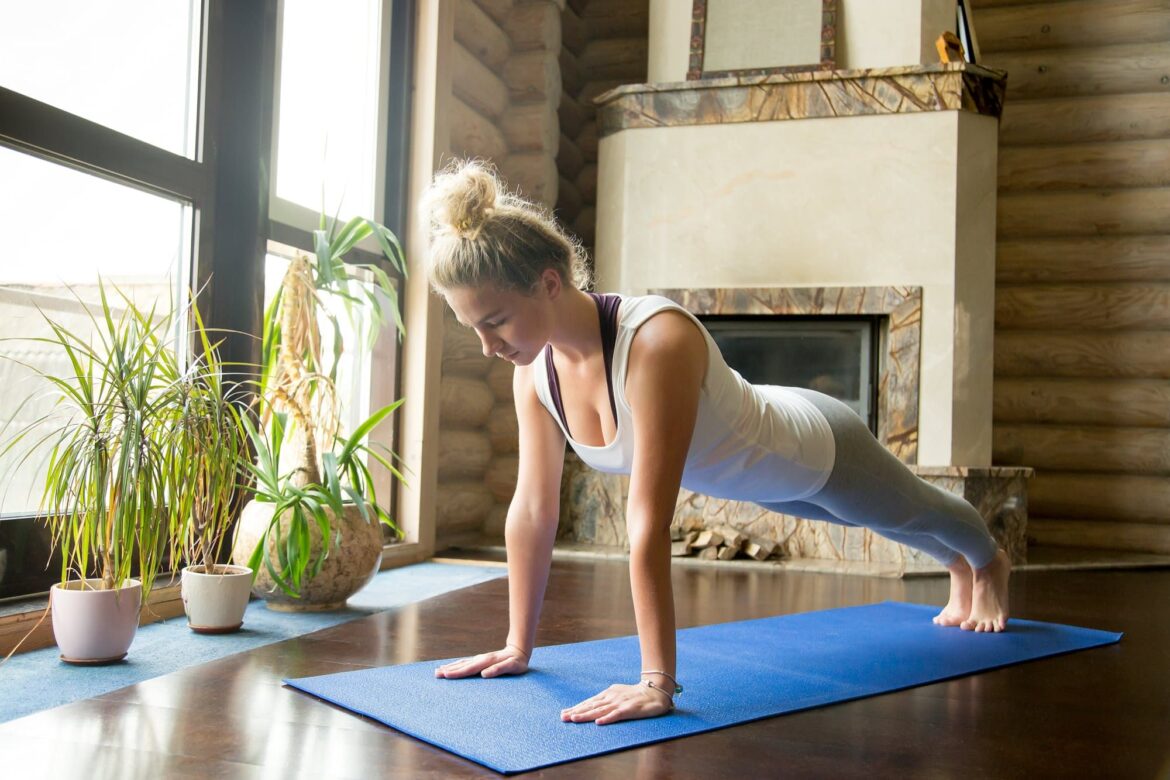Introduction
What Is Wall Pilates: Wall Pilates is a cutting-edge workout method that uses a wall for support and resistance. This innovative workout uses a wall as a prop and tool for stability and alignment while focusing on core strength, flexibility, and mindful movement. Wall’s full-body workout improves posture, balance, and physical health by targeting the core and other muscles.
Whether you’re a seasoned enthusiast or new to the practice, Wall Pilates can be a transformative and engaging way to achieve your fitness goals and promote overall health. In this introduction, we will explore the key principles and benefits of Wall Pilates, as well as how it differs from traditional Pilates and other fitness modalities.
Like traditional Pilates, Wall places a strong emphasis on core strengthening. The wall serves as a stable anchor, allowing individuals to perform a variety of exercises that engage the deep abdominal muscles, obliques, and lower back. This focus on core strength not only improves posture but also supports overall spinal health.
The wall provides a valuable reference point for alignment and posture correction. Practitioners can use the wall as a guide to ensure their bodies are properly positioned during exercises, reducing the risk of strain or injury. This heightened awareness of alignment can lead to improved posture both in and out of the studio.
Wall Pilates challenges balance and stability by utilizing the wall as a support system. This is especially beneficial for beginners or those recovering from injuries, as it helps build confidence and gradually improves balance over time.

Is Wall Pilates better than Pilates?
The resistance provided by the wall can also increase the intensity of the exercises, making them more challenging and effective. Wall Pilates is particularly beneficial for people with back pain, as it can help to improve posture and reduce pain.
Foundations of Traditional Pilates
Traditional Pilates was developed by Joseph in the early 20th century. It primarily focuses on mat-based exercises and the use of specialized equipment, such as the reformer, Cadillac, and chair. The core principles of traditional Pilates include concentration, control, centering, flow, precision, and breath. It aims to improve core strength, flexibility, and posture.
The Emergence of Wall Pilates
Wall Pilates is a more recent evolution of traditional , incorporating elements of the original method while adding the use of a wall as a supportive tool. The wall can provide stability, assistance, and resistance, making it a unique and innovative approach to Pilates practice.
Choosing the Right Option
The choice between Wall Pilates and traditional Pilates depends on your goals, fitness level, and personal preferences. If you seek a challenging, comprehensive workout with access to specialized equipment, traditional Pilates might be the better choice. On the other hand, if you value accessibility, stability, and functional movement, Wall Pilates can offer a unique and effective fitness experience.
Do Pilates walls really work?
Does Wall Pilates Tone Your Body? Yes, it can. A review of nine studies published in 2022 showed that this workout can improve body composition in terms of increased skeletal muscle mass and decreased body fat mass. More muscle and less fat equals a well toned body (7).
Do Pilates Walls Really Work
Strength and Toning: Pilates walls can help build strength and tone muscles, especially in the core, legs, and upper body.
Improved Flexibility: Regular use of Pilates walls can enhance flexibility and range of motion.
Posture Correction: Pilates walls promote better posture, which can have long-lasting benefits for spinal health and overall well-being.
Functional Fitness: Many Pilates wall exercises mimic everyday movements, contributing to functional fitness and improved daily life activities.
Choosing the Right Pilates Wall
There are various Pilates wall units available on the market, each with its own features and specifications. It’s important to choose one that aligns with your fitness goals, available space, and budget. Additionally, consider seeking guidance from a certified Pilates instructor to ensure you’re using the equipment correctly.
Does Wall Pilates reduce belly fat?
Does Pilates help reduce belly fat? While you’ll certainly burn calories, losing belly fat from Pilates is a myth. You can’t spot reduce fat anywhere on your body, regardless of the exercise. Think of your stored fat like a swimming pool.
Understanding Wall Pilates
Wall Pilates uses a wall as a support for basic Pilates exercises. It promotes core strength, flexibility, and body awareness. Wall Pilates works the whole body, especially the abs.
Interaction between exercise and belly fat
Exercise alone doesn’t reduce fat in certain locations. Physical exercise burns calories from several sources, not only fat. Create a calorie deficit through diet and exercise to lose belly fat.
Wall Pilates for Belly Fat Reduction
calorie expenditure: wall When paired with additional physical activity and a good diet, Pilates can burn calories.
Core Engagement: Wall Pilates emphasizes core engagement to build abdominal muscles. Stronger core muscles improve posture and abdominal tone.
Improved Body Composition: Regular Wall Pilates exercise can improve muscle tone and lean body mass, which boosts your resting metabolic rate and makes it easier to lose weight and fat.
Reduced Stress: Stress causes belly fat. Relaxation and careful breathing in Wall Pilates may reduce stress and belly obesity.
Does Wall Pilates burn fat?
The targeted movements of Wall Pilates target the core muscles, which are essential in weight loss, and help with fat reduction, making your metabolism rate faster.
The Mechanism of Fat Burning
To understand whether Wall Pilates can burn fat, it’s essential to grasp how the body burns fat during exercise. When you engage in physical activity, your body uses stored fat as a source of energy. The more intense the exercise and the longer the duration, the more fat your body can potentially burn.
How Wall Pilates Contributes to Fat Burning
Calorie Expenditure: Wall Pilates is a low-impact exercise that can help burn calories. While it may not burn as many calories as high-intensity workouts like running or cycling, it can contribute to a calorie deficit when combined with a healthy diet and other forms of physical activity.
Muscle Engagement: Wall Pilates places a significant emphasis on engaging core muscles and promoting overall muscle tone. Muscle tissue is metabolically active, meaning it burns more calories at rest than fat tissue. By building lean muscle through Wall Pilates, you can increase your resting metabolic rate, aiding in overall fat loss.
Improved Metabolism: Regular Wall Pilates practice can enhance your body’s metabolism, making it more efficient at burning calories and potentially facilitating fat loss.
Stress Reduction: Stress is known to contribute to fat retention, particularly in the abdominal area. Wall Pilates incorporates relaxation techniques and mindful breathing, which can help reduce stress levels and may indirectly support fat loss efforts.
What is 28 day wall Pilates?
The 28 Day Wall Pilates Challenge is an innovative program designed by Rachel from Rachel’s Fit Pilates. It combines traditional Pilates exercises with the added resistance and support of a wall, offering a unique workout experience over a span of 28 days.
The 28-Day Wall Pilates Program
The 28-Day Wall Pilates program is a structured workout plan that typically includes daily exercises for a span of four weeks. This program can be conducted under the guidance of a certified instructor or followed independently, provided you have the necessary equipment and familiarity with the exercises.
Components of the Program
Progressive Exercises: The 28-Day Wall Pilates program typically begins with foundational exercises that focus on building core strength and proper alignment. As the program progresses, more challenging movements are introduced to keep participants engaged and motivated.
Duration: Each daily session in the program can vary in duration, ranging from 20 to 45 minutes, depending on the specific exercises and their intensity. The gradual increase in session length allows participants to adapt and improve their endurance over time.
Variety: The program includes a variety of Wall Pilates exercises that target different muscle groups and areas of the body. This variety helps prevent boredom and ensures a comprehensive full-body workout.
Nutritional Guidance: In some 28-Day Wall Pilates programs, nutritional guidance and meal plans may be included to complement the exercise regimen and support overall health and wellness.
Is 20 minutes of Pilates a day enough?
For most individuals, sticking to 20 minutes for a session is enough. So, 20 minutes / 3 times a week is a good schedule to begin with. You may find that as you get more comfortable with the routines and you begin to get stronger and more flexibile that you will want to increase this to 30 minutes or more.
The 20-Minute Daily Pilates Routine
Consistency: The key to seeing benefits from a 20-minute daily Pilates routine is consistency. Daily practice allows you to build upon the progress you make each day, improving your strength, flexibility, and overall fitness over time.
Efficiency: Pilates is known for its focus on controlled, precise movements. In just 20 minutes, you can perform a series of exercises that target different muscle groups and provide a comprehensive workout.
Intensity: The intensity of your routine can vary. You can choose to do a more gentle routine for relaxation and flexibility or a higher-intensity session for a greater calorie burn and muscle engagement.
Supplementary Activities: While a 20-minute session can be beneficial, it can also be supplemented with other forms of exercise, such as cardio or strength training, to create a more well-rounded fitness program.
What are the effects of Wall Pilates?
Health Benefits
Wall Pilates is an excellent way to stretch your spine and help with better spinal alignment. The workout also puts a lot of focus on the abs, the glutes, and the back muscles, improving your core muscles and helping to reduce unhealthy curvature of the spine.
Improved Core Strength:
One of the primary focuses of Wall is strengthening the core muscles, including the abdominals, obliques, and lower back. Regular practice can lead to increased core strength, which is essential for stability, good posture, and reduced risk of back pain.
Enhanced Flexibility:
Wall includes a variety of stretching exercises that promote flexibility and improved range of motion. Stretching helps reduce muscle stiffness, increases joint mobility, and contributes to overall body suppleness.
Better Posture:
Wall Pilates encourages participants to maintain proper alignment during exercises. Over time, this attention to posture translates into improved posture in everyday life, reducing the risk of musculoskeletal issues and enhancing self-confidence.
Toning and Muscle Endurance:
Wall exercises engage various muscle groups, including the legs, arms, and glutes. This can lead to muscle toning and improved muscle endurance. Individuals often notice a more sculpted and defined physique with regular practice.
Can you do Wall Pilates everyday?
Pilates is safe enough to do every day. Initially you may want to do it every day so you get a rhythm and become consistent; then a good goal is to do it every other day.
Can You Do Wall Pilates Every Day
Intensity and Duration: Wall Pilates sessions can vary in intensity and duration. Light to moderate intensity sessions may be suitable for daily practice, while more intense sessions might require rest days in between. Listening to your body and adjusting the intensity accordingly is crucial.
Recovery: Like any exercise regimen, Wall Pilates places stress on the muscles and joints. Adequate rest and recovery are essential for muscle repair and growth. Consider incorporating rest days or lower-intensity sessions to allow your body to recover.
Variation: To prevent overuse injuries and avoid plateaus, it’s beneficial to vary your routine. Incorporate different exercises and focus on various muscle groups to keep your practice engaging and effective.
Consultation: If you’re new to Wall Pilates or have any underlying health conditions or injuries, it’s advisable to consult with a certified Wall Pilates instructor or healthcare professional before committing to daily practice. They can provide guidance and tailor a plan to meet your specific needs.

Conclusion
Wall Pilates is a creative twist on classic Pilates that uses a wall to improve core strength, alignment, and fitness. Wall Pilates is a dynamic and adaptive exercise for all fitness levels that uses the wall’s support and resistance. This unique exercise improves posture, balance, flexibility, and body awareness while strengthening the core.
Mindfulness and good alignment are promoted by using the wall Pilates as a reference point, minimizing injury risk and improving health and agility. Wall Pilates may be tailored to practitioners’ needs, making it a great alternative for full-body workouts. Wall Pilates is a unique and effective approach to reach your health and wellness objectives, whether you’re a Pilates aficionado trying to add a new depth to your practice or new to fitness.
To fully experience the benefits of Wall Pilates and ensure safe and effective practice, it is advisable to seek guidance from a certified instructor or healthcare professional. With dedication and regular practice, Wall Pilates can contribute to improved physical fitness, increased body awareness, and a greater sense of overall well-being.

